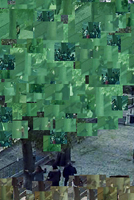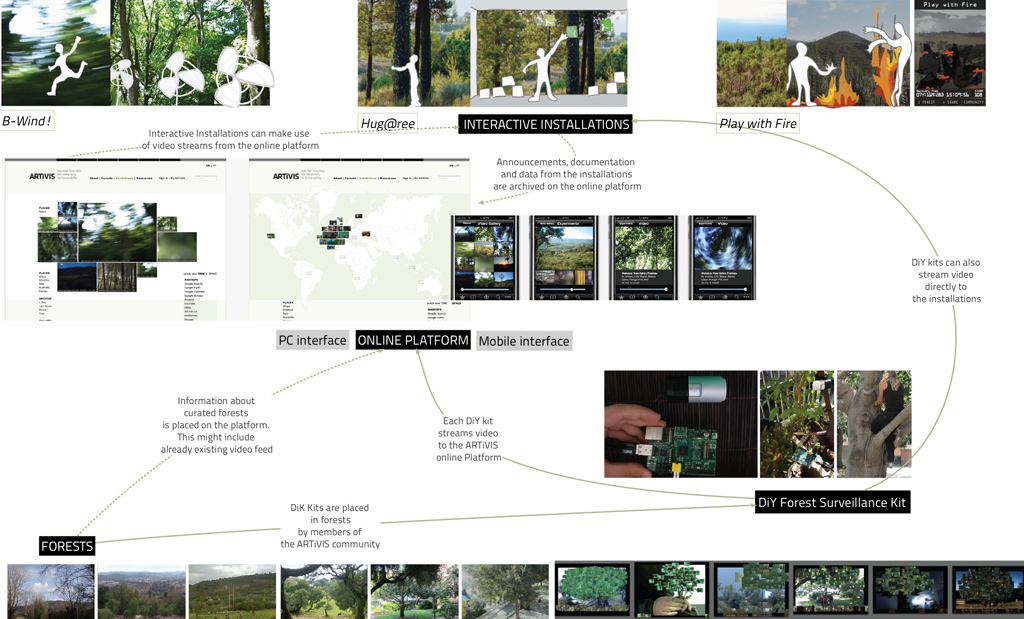
|

|
 |
 |
 |
|||
|
ARTiVIS DiY Kit Research Advisor --- |
Power Module provides power to the whole kit. For the kit’s intended function in remote forest locations it is important that it is autonomous in terms of power. This can be accomplished by using a rechargeable power supply, such as a lead or solid state battery coupled with a generating power source like a solar panel, a small wind turbine or a fuel cell. CPU Module is the brain of the system, it connects to all the other hardware modules and runs the ARTiVIS node software. Since the kit's design should take into account both portability and energy efficiency requirements, our first prototypes are being built with the Raspberry Pi, an ARM-based single-board Linux6 computer. Camera Module connects to the CPU Module and provides the images to the CPU for live video streaming. At its simplest configuration, the Camera Module can just be a good USB webcam connected to the CPU Module, but for a more integrated solution we will test interfacing high quality image sensors like the 1080p Leopard image sensor directly to the CPU Module. IO Module interfaces the CPU Module with a set of sensors and actuators that can be read and/or controlled remotely. For this we can use an Arduino board or a similar microcontroller-based IO hardware like the TI Launchpad or rely on the CPU module's native GPIO (General Purpose Input/Output) functionality. For early development this module was skipped since it’s not essential for the kit’s video streaming functionality. Network Module provides an interface to the Internet for the CPU Module. For early prototyping we used any network connectivity available to the test machine, but for the final reference design we will make use of external USB modems that provide 3G or 4G/LTE connectivity as these are more likely to be available in remote forests than WiFi or wired Ethernet.
Streaming Service The streaming service is the heart of the system. At its core it’s a video processing pipeline based on the GStreamer framework that captures the live images off the Camera Module, encodes them using a Free lossy codec like Ogg Theora or Webm and streams them to the ARTiVIS server for online distribution. It could also optionally record the video locally for backup purposes. IO Service interfaces with the IO Module hardware, multiplexing access and providing to applications an API that abstracts the underlying hardware, thus permitting access to the sensors and actuators connected to the IO Module. Web Service a web application that runs on an embedded web server on the CPU Module and provides a simple way for the kit’s owner to control and configure it. It also provides a REST API that would allow for external control and connectivity to and from the ARTiVIS server to allow uploading of sensor data to the platform and the downloading of actuator commands. Server Components The development of the server software is beyond the scope of the hardware kit’s development. For prototyping we are using a streaming server like Icecast and tested the use of open data syndication platforms like GISS (Global Independent Streaming Support) for video and ThingSpeak for sensor data.
The ARTiVIS DiY kit Open Source repository includes project schematics and code, hoping to spark a developer community around the project that helps maintain, improve and adapt the kit to specific environments and for other purposes – for instance, replacing expensive hardware setups for remotely watching animal behavior.
--- Recognizing that “to prevent and control destructive forest fires, the involvement of communities is crucial” [FAO04], we propose to trigger people's participation from the project's grounds, involving the ones willing to contribute to expand the raw material database through a workshop on DIY Forest Surveillance with ARTiVIS.
|
ARTiVIS DiY kit Open Source repository section » WORKSHOPS REFERENCES RIZKALA, C. E., J. Therien, A. Savage (2009) “Observations of Nesting Short-Tailed Hawks in Central Florida”, Florida Field Naturalist, vol. 37, no. 1, pp. 1–32. Refarm the City – Tools for Urban Farmers VIGILIA Open Design Raspberry Pi
|
||||




